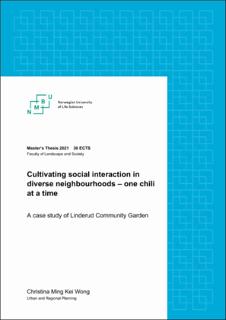Cultivating social interaction in diverse neighbourhoods – one chili at a time - A case study of Linderud Community Garden
Master thesis
Permanent lenke
https://hdl.handle.net/11250/2990811Utgivelsesdato
2021Metadata
Vis full innførselSamlinger
- Master’s theses (LandSam) [1063]
Sammendrag
This thesis looks at how a community garden can support social interaction in diverse neighbourhoods. It draws upon the case of Linderud Community Garden, an urban garden in Oslo. The Norwegian government launched in February 2021 a national strategy for urban agriculture, where one of the goals is to achieve social inclusion through urban agricultural projects. Our cities have become more diverse over the last decades, and many minorities experience discrimination and exclusion based on their background. Social interaction in public space, both fleeting and meaningful encounters, are believed to build tolerance. While the positive social effects of urban agriculture are well supported in the academic literature, there are also evidence of the risks of exclusion and gentrification. The national strategy advocates for an integration of urban agriculture in city planning, yet there is little formal knowledge on how it should be implemented in planning practice. This thesis thus seeks to contribute to the knowledge on community gardens in diverse neighbourhood to inform planning practice.
Through spatial mapping, observation and interviews I have investigated how Linderud Community Garden supports social interaction through how the spatial and social organization affect the use of the garden. I have looked into who the users of the garden are and whether it reflects those who are underrepresented in public outdoor spaces in the neighbourhood.
The results demonstrates that a central location close by elemental public functions allows for frequent visits that can be combined with daily routines. It also illustrates how the function of a publicly accessible green space with social area and as a part of the mobility network attracts different types of users to the space for recreation and promenade, regardless of gardening interest. Furthermore, it shows that the social organization plays a significant role in determining both the gardening and public users. The presence of public users seems to be determined by what type of group the frequenting gardeners represent, whether it be minorities, youth or elderly.
